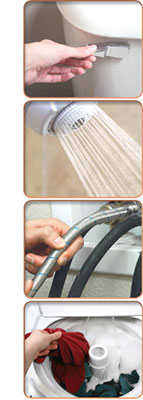
Fixing leaks and installing a few inexpensive water-saving devices in your home could save up to 20,000 gallons of water each year.
Unless your home was built after 1995, you probably have pre-conservation era plumbing that guzzles water. Fixing leaks and replacing old plumbing fixtures with water-saving models are two easy ways to conserve water and save money at the same time.
In addition, you pay to pipe water into your home and pay to pipe it out unless you have a septic tank. Most water-conserving devices will reduce your water and sewer bill enough to pay for themselves within six months. Therefore, it pays to fix it for less and save.
Here are some additional tips to save water in the bathroom and kitchen:
- Check for leaks at your faucet, toilet and showerhead.
- Use a high-efficiency showerhead that flows at a rate of two gallons per minute.
- Replace leaky or old fixtures with WaterSense® products.
Save water in the laundry room with these simple tips:
- Check your washing machine hoses for leaks.
- Wash only full loads or check and adjust your water level when washing smaller loads.
- When you need to replace your washer, choose an ENERGY STAR®model.

The District’s “Fix It for Less” Campaign will begin April 1 in conjunction with Water Conservation Month. The campaign focuses on three areas of the home — the bathroom, kitchen and laundry room — and encourages homeowners to fix leaks and replace old plumbing fixtures to save both water and money.
The campaign features a new website at WaterMatters.org/FixItForLess/, how-to videos and a brochure assisting homeowners in identifying areas that could benefit from installing simple water-saving devices and providing easy step-by-step instructions.
